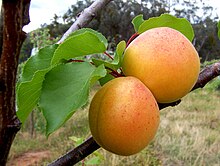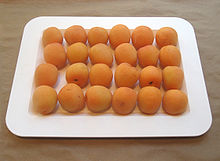| Apricot | |
|---|---|
 | |
| Apricot fruits | |
| Conservation status | |
| Scientific classification | |
| Kingdom: | Plantae |
| Division: | Magnoliophyta |
| Class: | Magnoliopsida |
| Order: | Rosales |
| Family: | Rosaceae |
| Genus: | Prunus |
| Subgenus: | Prunus |
| Section: | Armeniaca |
| Species: | P. armeniaca |
| Binomial name | |
| Prunus armeniaca L. | |
| Synonyms | |
| Armeniaca vulgaris Lam.[1] Amygdalus armeniaca (L.) Dumort.[1] | |
Contents |
Description

Apricot tree in central Cappadocia, Turkey
Cultivation and uses
History of cultivation
| Nutritional value per 100 g (3.5 oz) | |
|---|---|
| Energy | 201 kJ (48 kcal) |
| Carbohydrates | 11 g |
| Sugars | 9 g |
| Dietary fiber | 2 g |
| Fat | 0.4 g |
| Protein | 1.4 g |
| Vitamin A equiv. | 96 μg (11%) |
| - beta-carotene | 1094 μg (10%) |
| Vitamin C | 10 mg (17%) |
| Iron | 0.4 mg (3%) |
| Percentages are relative to US recommendations for adults. Source: USDA Nutrient database | |
| Nutritional value per 100 g (3.5 oz) | |
|---|---|
| Energy | 1,009 kJ (241 kcal) |
| Carbohydrates | 63 g |
| Sugars | 53 g |
| Dietary fibre | 7 g |
| Fat | 0.5 g |
| Protein | 3.4 g |
| Vitamin A equiv. | 180 μg (20%) |
| - beta-carotene | 2163 μg (20%) |
| Vitamin C | 1 mg (2%) |
| Iron | 2.7 mg (22%) |
| Percentages are relative to US recommendations for adults. Source: USDA Nutrient database | |
Its introduction to Greece is attributed to Alexander the Great,[8] and the Roman General Lucullus (106–57 B.C.) also exported some trees – the cherry, white heart cherry, and apricot – from Armenia to Europe. Subsequent sources were often confused about the origin of the species. Loudon (1838) believed it had a wide native range including Armenia, Caucasus, the Himalaya, China, and Japan.[9]
Today the cultivars have spread to all parts of the globe with climates that support it.
Apricots have been cultivated in Persia since antiquity, and dried ones were an important commodity on Persian trade routes. Apricots remain an important fruit in modern-day Iran where they are known under the common name of Zard-ālū (Persian: زردآلو).
Egyptians usually dry apricots, add sweetener, and then use them to make a drink called "'amar al-dīn."
More recently, English settlers brought the apricot to the English colonies in the New World. Most of modern American production of apricots comes from the seedlings carried to the west coast by Spanish missionaries. Almost all U.S. production is in California, with some in Washington and Utah.[10]
Many apricots are also cultivated in Australia, particularly South Australia, where they are commonly grown in the region known as the Riverland and in a small town called Mypolonga in the Lower Murray region of the state. In states other than South Australia, apricots are still grown, particularly in Tasmania and western Victoria and southwest New South Wales, but they are less common than in South Australia.
Cultivation

Dried organic apricot, produced in Turkey. The colour is dark because it has not been treated with sulfur dioxide (E220)
Apricot cultivars are most often grafted on plum or peach rootstocks. The scion from an existing apricot plant provides the fruit characteristics such as flavour, size, etc., but the rootstock provides the growth characteristics of the plant. Apricots and plums can hybridize with each other and produce fruit that are variously called pluots, plumcots, or apriums.
Apricots have a chilling requirement of 300 to 900 chilling units. They are hardy in USDA zones 5 through 8. Some of the more popular US cultivars of apricots include Blenheim, Wenatchee Moorpark, Tilton, and Perfection.
There is an old adage that an apricot tree will not grow far from the mother tree. The implication is that apricots are particular about the soil conditions in which they are grown. They prefer a well-drained soil with a pH of 6.0 to 7.0. If fertilizer is needed, as indicated by yellow-green leaves, then 1/4 pound of 10-10-10 fertilizer should be applied in the second year. Granular fertilizer should be scattered beneath the branches of the tree. An additional 1/4 pound should be applied for every year of age of the tree in early spring, before growth starts. Apricots are self-compatible and do not require pollinizer trees, with the exception of the 'Moongold' and 'Sungold' cultivars, which can pollinate each other. Apricots are susceptible to numerous bacterial diseases including bacterial canker and blast, bacterial spot and crown gall. They are susceptible to an even longer list of fungal diseases including brown rot, black knot, Alternaria spot and fruit rot, and powdery mildew. Other problems for apricots are nematodes and viral diseases, including graft-transmissible problems.
Production trends
| Top eleven apricot producers—2005 (1,000 tonnes) | |
|---|---|
| 390 | |
| 285 | |
| 232 | |
| 220 | |
| 196 | |
| 181 | |
| 145 | |
| 136 | |
| 123 | |
| 103 | |
| 101 | |
| World total | 1916 |
| Source:[12] | |
Kernels
Main article: Apricot kernel
Seeds or kernels of the apricot grown in central Asia and around the Mediterranean are so sweet that they may be substituted for almonds. The Italian liqueur amaretto and amaretti biscotti are flavoured with extract of apricot kernels rather than almonds. Oil pressed from these cultivar kernels, and known as 'Oil of Almond', has been used as cooking oil. Kernels contain between 2.05% and 2.40% hydrocyanic acid, but normal consumption is insufficient to produce serious effects. [14][clarification needed]Medicinal and non-food uses
Cyanogenic glycosides (found in most stone fruit seeds, bark, and leaves) are found in high concentration in apricot seeds. Laetrile, a purported alternative treatment for cancer, is extracted from apricot seeds. Apricot seeds "were used against tumors as early as A.D. 502. In England during the seventeenth century, apricot oil was also used against tumors, swellings, and ulcers".[15] In 2005, scientists in the Republic of Korea found that treating human prostate cancer cells with amygdalin induces programmed cell death. They concluded that "amygdalin may offer a valuable option for the treatment of prostate cancers".[16]In Europe, apricots were long considered an aphrodisiac, and were used in this context in William Shakespeare's A Midsummer Night's Dream, and as an inducer of childbirth, as depicted in John Webster's The Duchess of Malfi.
Due to their high fiber to volume ratio, dried apricots are sometimes used to relieve constipation or induce diarrhea. Effects can be felt after eating as few as three.
Research shows that of any food, apricots possess the highest levels and widest variety of carotenoids[citation needed]. Carotenoids are antioxidants that help prevent heart disease,[citation needed] reduce "bad cholesterol" levels,[citation needed] and protect against cancer.[citation needed] Although initial studies suggested that antioxidant supplements might promote health, later large clinical trials did not detect any benefit and suggested instead that excess supplementation may be harmful.[17] In traditional Chinese medicine, apricots are considered helpful in regenerating body fluids, detoxifying, and quenching thirst[citation needed].
Etymology
The scientific name armeniaca was first used by Gaspard Bauhin in his Pinax Theatri Botanici (page 442), referring to the species as Mala armeniaca "Armenian apple". It is sometimes stated that this came from Pliny the Elder, but it was not used by Pliny. Linnaeus took up Bauhin's epithet in the first edition of his Species Plantarum in 1753.[18]The name apricot is probably derived from a tree mentioned as praecocia by Pliny. Pliny says "We give the name of apples (mala) ... to peaches (persica) and pomegranates (granata) ..."[19] Later in the same section he states "The Asiatic peach ripens at the end of autumn, though an early variety (praecocia) ripens in summer – these were discovered within the last thirty years ...".
The classical authors connected Greek armeniaca with Latin praecocia:[20] Pedanius Dioscorides' " ... Ἀρμενιακὰ, Ῥωμαιστὶ δὲ βρεκόκκια"[21] and Martial's "Armeniaca, et praecocia latine dicuntur".[22] Putting together the Armeniaca and the Mala obtains the well-known epithet, but there is no evidence the ancients did it; Armeniaca alone meant the apricot.
Accordingly, the American Heritage Dictionary under apricot derives praecocia from praecoquus, "cooked or ripened beforehand" [in this case meaning early ripening], becoming Greek πραικόκιον "apricot" and Arabic al-barqūq "apricot" (although in most of the Arab world the word now means "plum").
The English name comes from earlier "abrecock" in turn from the Middle French abricot, from Catalan abercoc.[23] Both the Catalan and the Spanish albaricoque were adaptations of the Arabic, dating from the Moorish occupation of Spain. The name apricock is sometimes still used in English.[citation needed]
However, in Argentina and Chile the word for "apricot" is damasco, which probably indicates that, to the Spanish settlers of Argentina, the fruit was associated with Damascus in Syria.[24]
In culture
The Chinese associate the apricot with education and medicine. For instance, the classical word 杏壇 (literally: 'apricot altar') which means "educational circle", is still widely used in written language. Chuang Tzu, a Chinese philosopher in 4th century BCE, told a story that Confucius taught his students in a forum surrounded by the wood of apricot trees.[25]The fact that apricot season is very short has given rise to the very common Egyptian Arabic and Palestinian Arabic expression "filmishmish" ("in apricot [season]") or "bukra filmishmish" ("tomorrow in apricot [season]"), generally uttered as a riposte to an unlikely prediction, or as a rash promise to fulfill a request.
Among United States Marine Corps tank-driving soldiers, apricots are taboo, by superstition. Marine Corps tankers will not eat apricots, allow apricots onto their vehicles, and often will not even say the word "apricot". This superstition stems from Marine Sherman tank breakdowns purportedly happening in the presence of cans of apricots.[26]
The Turkish idiom "bundan iyisi Şam'da kayısı" (literally, the only thing better than this is an apricot in Damascus) means "it doesn't get any better than this" and used when something is the very best it can be; like a delicious apricot from Damascus.






No comments:
Post a Comment